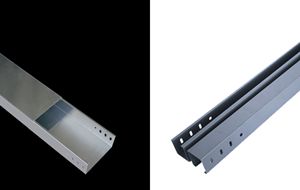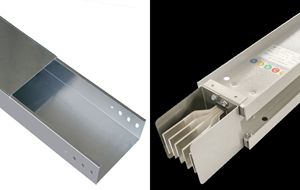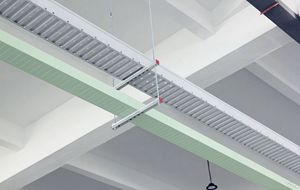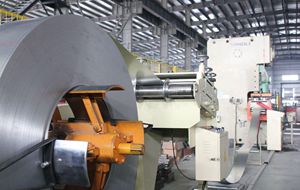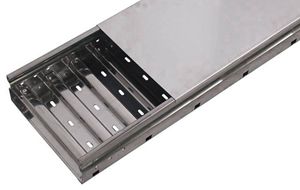-
Differences between fire-resistant cable tray and ordinary cable tray
The fire-resistant cable tray is to spray a layer of fire-resistant paint on the surface of the ordinary cable tray to play the role of fire-retardant and fire-retardant! In fact, the cable tray itself does not catch fire, only the cable may catch fire. Fire cable trays are different from ordinary cable trays in three points: Firstly, different functions: Fireproof cable tray: The fireproof cable tray is to spray a layer of fireproof paint on the surface of the ordinary cable tray to play the role of fire retardant. 2.Ordinary cable trays: The cable trays in the building can be erected independently, or can be attached to various building (structure) and pipe corridor supports, should reflect the characteristics of simple structure, beautiful appearance, flexible configuration and convenient maintenance, all parts need to be galvanized and installed on the open cable tray outside the building. Secondly, different structure: 1.Fireproof cable tray: The fireproof cable tray has a matte surface and is generally used in the distribution lines of firefighting equipment, including fire control rooms, fire pumps, fire elevators, smoke exhaust fans and automatic fire alarm systems, except for fire alarms. Fire-resistant cables can be used for other distribution lines outside the system, without the use of fireproof cable trays. Ordinary cable tray: The cable tray is divided into cable trunking, perforated cable tray and cable ladder, net format and other structures, which are composed of brackets, supporting arms and installation accessories.…
Learn More -
The difference between Cable Tray and Busway
The difference of function Cable tray, used in cable laying, belongs to the bracket, generally used to help support and protect the cable. busway, similar to cable, it is for AC 50HZ,380V three-phase four-wire system or three-phase five-wire system power distribution system transmission of electricity, can replace the cable distribution mode. The difference of composition The general name of the rigid layout system composed of bracket, supporting arm, installation accessories and so on, which has a dense supporting cable; busway is a bus system composed of metal plate as protective shell, conductive bar, insulating material and related accessories. The difference of size and specification The cable tray is relatively large and the busway is relatively small. If there are many cables and wires, a cable tray is recommended. The difference of intensity The cable tray is mainly used for laying power cables and control cables, and the busway is usually used for laying wires and communication cables. The difference of turning radius Cable tray turning radius is relatively large, most of the busway turn right Angle. The difference of span The span of cable tray is larger and the busway is smaller. Therefore, the fixed bracket difference is large, the number of support hanger difference. The difference of tightness Metal busway sealing is good, not necessarily the support of the bracket, can be laid in the cable trench and building inter layer. Some of…
Learn More -
Introduction of Cable Trays
Introduction: Today cable trays have become a necessary part of industrial and commercial construction by offering quick, economical and flexible solutions to these problems. Cable trays are capable of supporting all types of wiring: 1. High Voltage Power Lines. 2. Power Distribution Cables 3. Sensitive Control Wiring 4. Telecommunication Wiring 5. Optical Cables Cable Tray Materials: Most cable tray systems are fabricated from a corrosion-resistant metal (low-carbon steel, stainless steel or an aluminium alloy) or from a metal with a corrosion-resistant finish (zinc or epoxy). The choice of material for any particular installation depends on the installation environment (corrosion and electrical considerations) and cost. (1) Aluminium: Cable trays fabricated of extruded aluminium are often used for their high strength-to-weight ratio, superior resistance to certain corrosive environments, and ease of installation. They also offer the advantages of being light weight (approximately 50% that of a steel tray) and maintenance free, and since aluminium cable trays are non-magnetic, electrical losses are reduced to a minimum. Cable tray products are formed from the 6063 series alloys which by design are copper free alloys for marine applications. These alloys contain silicon and magnesium in appropriate proportions to form magnesium silicate, allowing them to be heat treated. These magnesium silicon alloys possess good formability and structural properties, as well as excellent corrosion resistance. The unusual resistance to corrosion, including weathering, exhibited by aluminium is due to the self-healing aluminium…
Learn More -
Automatic Production Line for Cable Tray
After entering the 21st century, mechanical automation technology has achieved rapid development. With the overall development of automation technology, it has been widely used in the field of social production and life, and the application value of mechanical automation in the field of production has gradually emerged. At the same time, Shanghai Xinma busbar bridge frame Co., ltd also follows the trend of the times. Through the application of automation technology, the production efficiency of machinery manufacturing has been comprehensively improved, the labor cost of production has been reduced, the mechanized production rate has been improved, and many shortcomings in the former machinery production have been improved, which has a good role in promoting the overall development of machinery manufacturing industry. Shanghai Xinma busbar Bridge Co., Ltd. makes full use of mechanical automation technology to produce cable bridge. This technology is fully used in the bending, cutting and molding of the bridge, which greatly improves the production efficiency of the products. Intelligent Manufacturing & Efficient The application of automation technology in mechanical manufacturing is mainly based on mechanical technology and electronic technology, and the combination of multiple technical disciplines is strengthened. Through mechanical automation, the original technical structure,product composition, product production mode and management system of the mechanical industry can be changed correspondingly, and the basic characteristics of traditional industrial production begin to change in stages. Mechanical automation technology is a comprehensive technology effectively combined by many technical groups. Intelligent…
Learn More -
XMBG Series Corrugated Cable Tray
Brief introduction of XMBG Series Corrugated Cable Tray XMBG Series Corrugated Cable Tray (referred to as “XMBG Cable Tray”) has advantage of energy saving, light weight, high strength and corrosion resistance. As ideal replacement product, It’s more economic and technical than traditional. New technologies, new products-cast new standards for industry The innovation of XMBG cable tray is that it uses a three-dimensional structure instead of the traditional flat structure according to the principle of material mechanics, which greatly improves the mechanical strength of the cable tray , reduces the thickness of the steel plate and own weight, and saves resources. The product complies with T/CECS31-2017 "Technical Specifications for Steel Cable cable tray Engineering", which specifies the requirements for the design and selection of cable trays. The national standard GB/T23639-2017 "Energy-saving and corrosion-resistant steel cable tray" compiled in 2017 was formally implemented in December 2017. With the implementation of design regulations and national standards, XMBG cable trays will create unlimited economic benefits for society. XMBG Series Corrugated Cable Tray Material saving and energy saving-creating benefits One of the innovations of XMBG cable tray is to achieve energy saving through superior heat dissipation performance.The energy-saving principle of XMBG cable tray is through innovative structural design, using heat conduction and air heat exchange, to maximize the heat generated by the cable conductor in the cable tray to be fully dissipated, thereby reducing the resistance value and loss of power lines and improving…
Learn More





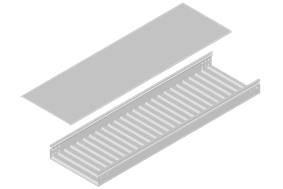 Solid Corrugated Cable Tray
Solid Corrugated Cable Tray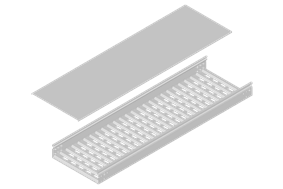 Perforated Corrugated Cable Tray
Perforated Corrugated Cable Tray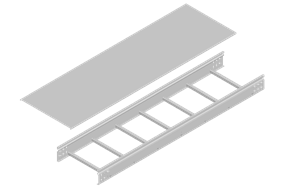 Ladder Corrugated Cable Tray
Ladder Corrugated Cable Tray